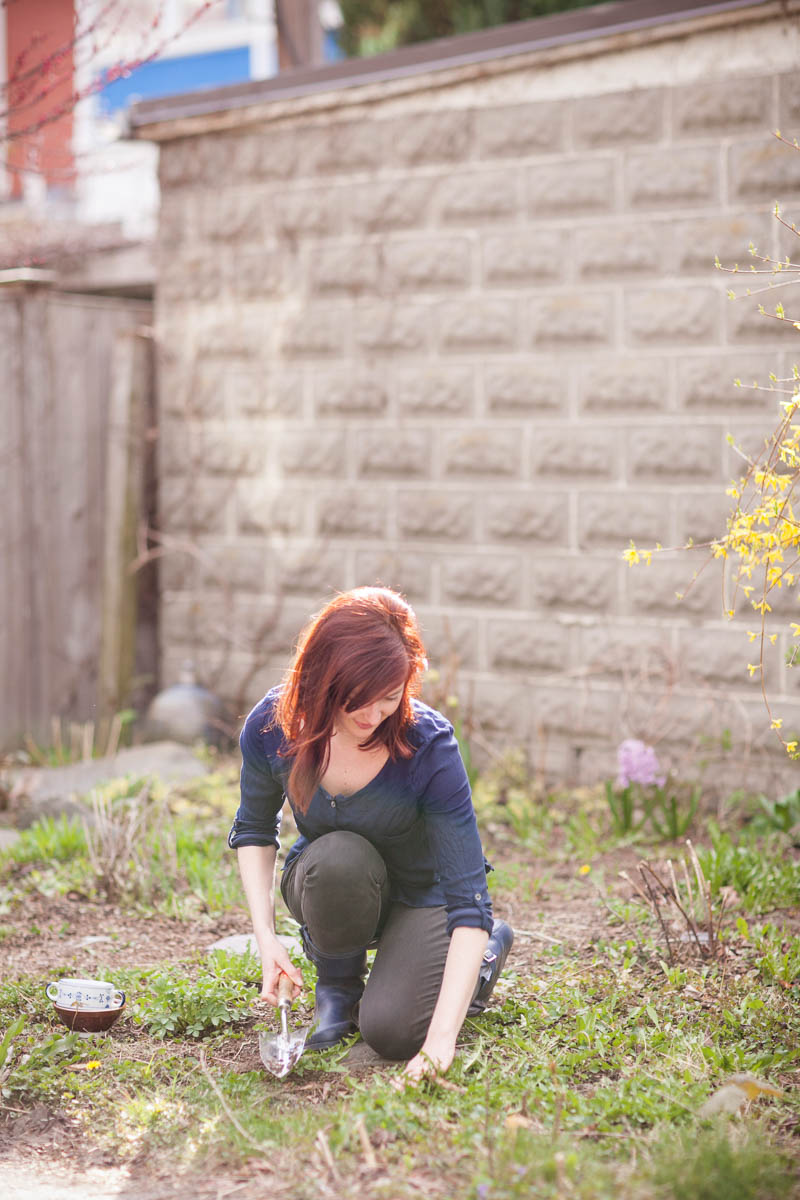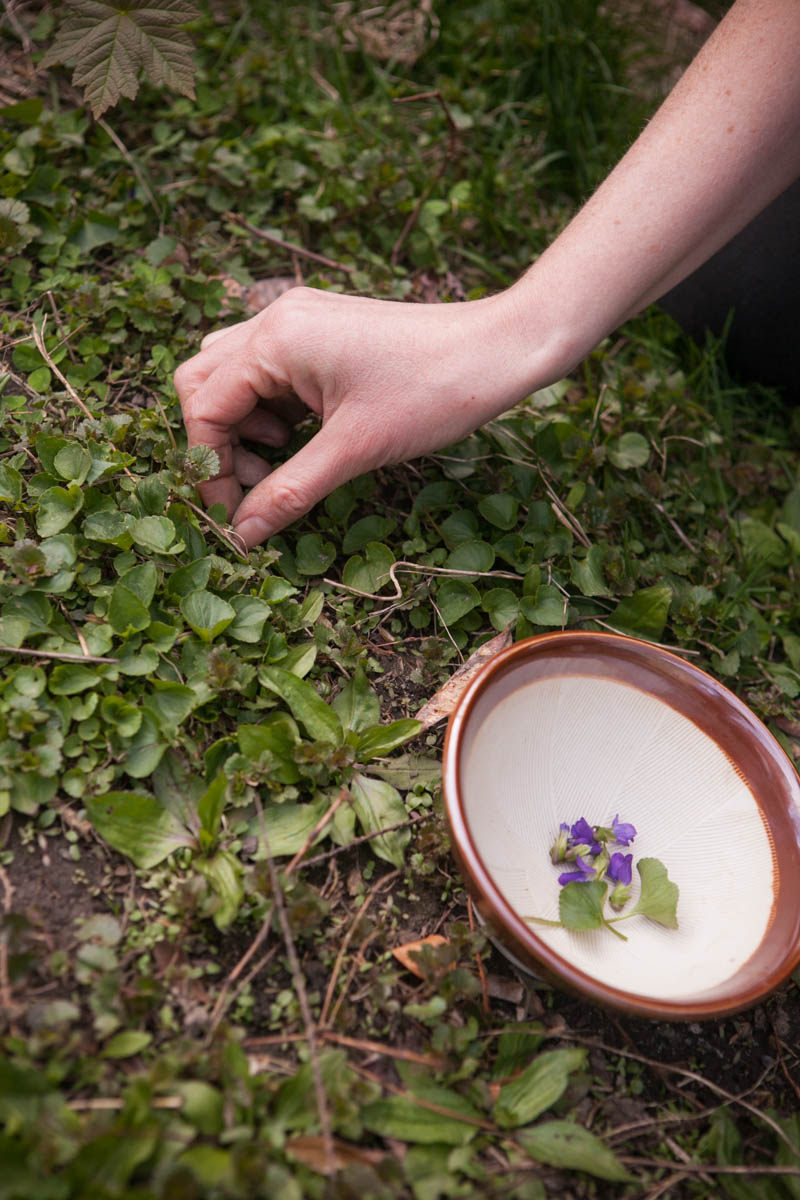The Wild Ones Amongst Us: Weedy Spring Plants As Food & Medicine
The Wild Ones Amongst Us:
Weedy Spring Plants As Food & Medicine
Words by Steph Zabel of www.flowerfolkherbs.com
Photography by Todd Danforth, www.toddjdanforth.com
As a city-dwelling herbalist, I am surrounded by rivers of concrete and miles of densely-packed buildings. This leaves little room for the wild and overgrown green places that are so near and dear to my heart. However, there are benefits to being a city-bound plant lover who craves untamed places. Living in the midst of the concrete jungle forces you to deliberately be on the lookout for weedy patches of rogue plants. It forces you to be present and alert in your environment, and to appreciate the dynamic cohabitation of plants and people in a dense and bustling cityscape. You realize that once you start looking for wild plants, you will notice them everywhere. Amongst the weedy plant species it seems that there are few places where their vitality cannot emerge.
In my own urban backyard – a modest little plot hemmed in by houses, fences and driveways – there are plants that were never planted there: dandelions, ground ivy, violets, plantain, celandine, wild carrot, mugwort, and more. These are wild spontaneous growers, or as most people would say, “weeds.” I love these wild ones and let them have their place in the garden, amongst the intentionally planted herbs. I delight in these weeds, for they are often the first bit of green to emerge in the spring, and the last to go dormant when the cold season descends.
Not too long ago, these wild ones were appreciated for their food and medicinal use, and celebrated when they returned to us each spring. Here are three of my favorite wild weeds – ones that are commonly found in both urban and rural areas, wherever humans reside.
Dandelion | Taraxacum Officinale
Dandelion is beloved by herbalists and wild food foragers alike. As a wonderful tonic, it strengthens our livers, and steadily improves our digestion. The whole plant is edible – roots, leaves, flowers, even the seeds – and contains many vitamins and minerals. Sprinkle the flower petals on salads, eat the bitter leaves raw or sautéed, or try roasting the root for a delicious coffee substitute. Or, as I like to do, infuse the whole plant in vinegar.
Vinegar has been used as a health-promoting ingredient for centuries, and for all maladies under the sun. In the kitchen, it serves as a useful medium for extracting mineral-rich plants such as dandelion. This herbed vinegar can then be used on salads, roasted vegetables, or for the base of sauces. If you are feeling adventurous, you can also drink it by the shot for a healthy and energizing pick-me-up!
Dandelion Infused Vinegar
Choose a good place to harvest your dandelions. If collecting in the city you want to be sure you are in an area free of any heavy metals and pollutants that may exist in the soil and surrounding environment. Don’t harvest right next to a busy road. Consider how other people, animals and cars may have affected the plants in the area. As with any wild harvesting, look for plants that are vibrant and healthy, and respectfully gather only what you need.
- Use a small trowel to gently dig around the dandelions, removing soil around the main taproot as you go. Try to unearth as much of the root as possible. Gather 4-6 whole dandelions, enough to fill a pint-sized glass jar when chopped.
- Rinse your dandelion roots and leaves well, removing the soil and using a very gentle scrub brush if necessary. Discard any brown or tired-looking leaves.
- Pat dry and leave for a few hours if you can, until the dandies are completely dried. Ideally, let them wilt for a day or two to remove any excess water in the plant. This will result in stronger infused vinegar.
- Chop up all the roots and leaves, and fill your pint jar to the top, but don’t pack it in too much.
- Cover the whole thing with apple cider vinegar, stirring to remove any air bubbles. Top off with more vinegar.
- Be sure to cover the top of the jar with a sheet of wax paper if you are using a metal lid, since vinegar will corrode metal. Then cap, label with the ingredients and date, and place the jar somewhere in your kitchen where you will see it often.
- Shake daily.
- After 2-3 weeks, taste your vinegar and see if the flavor is to your liking. If so, use a fine sieve to strain out the dandelion parts.
- Bottle the remaining infused vinegar, label, and store out of direct sunlight. Keep it in the fridge for the longest shelf life, and use within 6 months.
Ground Ivy | Glechoma Hederacea
Ground Ivy is a low-growing plant with dainty purple flowers that commonly appears uninvited in gardens and lawns. It is a member of the mint family, and like its cousins, has an aromatic scent when crushed. This property gives a clue to some of its medicinal virtues, for it is a plant traditionally used to alleviate coughs, congestion, and headaches. Like dandelion, it is also a wild edible and you can use the leaves and flowers as part of a fresh salad. You can also dry the flowering plant for tea, or make it into a tincture. Another lovely way to use ground ivy is to create an oxymel with it.
Oxymels are ancient preparations that involve the combination of honey, vinegar and herbs. This simple medicine dates back to the time of the great Greek physicians and has been used for many different ailments, but most especially for digestive and respiratory issues. Oxymels are one of my favorite and most delicious ways to preserve herbs, and are a wonderful medicinal tonic. They can be taken straight by the spoonful or added to sparkling water (or even cocktails) for a special treat.
Ground Ivy Oxymel
- Collect your fresh ground ivy, enough to fill a pint-sized jar. Make sure any excess water has evaporated before using, or let it wilt for a day if you can.
- Chop up the bunch and fill a pint-sized glass jar to the top.
- In a separate bowl, mix together equal parts apple cider vinegar and local honey: start with nearly 1 cup of each.
- Cover your herbs with the honey-vinegar blend so that all plant material is covered. You can also adjust the ratio of honey to vinegar if desired: if you want a thinner oxymel, add more vinegar, if you want a thicker, more syrupy oxymel, add more honey.
- Stir up the herb mixture and cover the top of the jar with a sheet of wax paper before capping. Make sure all the plant material is covered by the honey-vinegar combination.
- Shake daily and check that the herbs stay completely covered. Top with a little vinegar if needed.
- Let steep for 2 – 4 weeks, tasting at intervals.
- Strain out the ground ivy through a sieve and store in a tightly capped bottle out of direct sunlight, preferably in the fridge. Use within 6 months.
Violet | Viola Odorata & Related Species
The violets start unfolding their heart-shaped leaves as soon as spring begins its arrival. Then, all of a sudden, their brilliantly hued flowers appear. Just to gaze upon them is a balm for winter-weary eyes. Highly regarded in traditional herbal folklore as a nutritious spring food plant, violets also possess extremely soothing and cooling properties that assist with inflammatory conditions, itchy skin, or sore, scratchy throats. Herbalists in old days used violet to “comfort and strengthen the heart;” we modern-day humans can still turn to this sweet, beautiful flower for the same purpose.
The violet syrup recipe on the following page is a wonderful and delicious way to preserve this ephemeral flower. Using sugar allows the delicate violet flavor to come through, but honey can also be used. Preserving the beautiful color of this syrup can sometimes be tricky – just be sure to allow the violets to steep for several hours to extract the most color from their petals. Also, if the final color is not what you hoped for, you can add some lemon juice to perk it up – just stir in a few drops and you will immediately see the liquid change to a magenta color! This syrup can be used as a garnish on desserts, added to sparkling water, or used as a remedy for sore throats.
Simple Violet Infused Syrup
- Collect 1 cup of gently packed violet flowers.
- Place the flowers in a glass bowl and cover them with 1.5 cups of boiling water.
- Let this mixture steep overnight, or at least 6 hours so that the violets are completely drained of their color. The resulting liquid should be a purplish-blue color.
- Strain out the flowers.
- Pour the violet liquid into a small saucepan, turn the heat to medium and add 3 cups of sugar.
- Stir as the sugar dissolves. Heat and stir for 5-10 minutes, making sure it never boils.
- Remove from the heat and pour the resulting syrup in a clean, glass jar. Label, store in the fridge, and use within 6 months.























